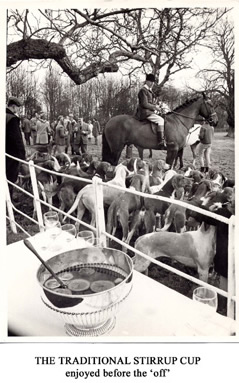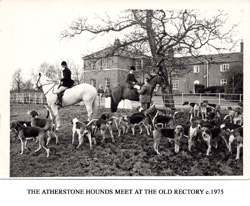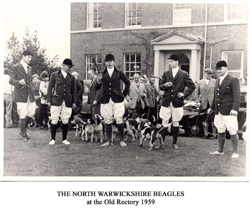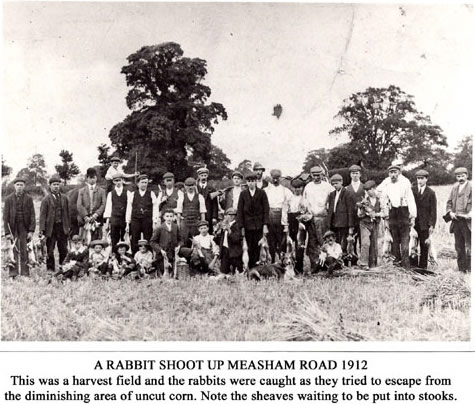Appleby History > In Focus > 24 - High Days & Holidays
Chapter 24
High Days and Holidays
Wakes Weeks and Whitsuntide Walks
by Richard Dunmore
In a 19th century country village dominated by a large agricultural estate, working hours were long and there was little time for non-productive 'leisure' activities as we know them today. Although the burden of employed work had seasonal rhythms, there were always jobs to be done at home growing vegetables and raising and tending animals such as poultry and pigs. Of course women played a vital role in this domestic husbandry too. Despite all the hard work, opportunity was taken to enjoy life when occasion arose. Annual holidays and a variety of country rituals were eagerly anticipated and enjoyed to the full.
Religious Festivals
Christmas, Easter and Whitsun together with saints' days, especially the patronal festival of the parish church, provided the annual holidays. Many of these survived the Elizabethan and Cromwellian reformations. The very word holiday of course originates from Holy Day. Boxing Day, Easter Monday and Whit-Monday were 'holidays' following the respective major festivals; and Wakes Week followed the celebration of the feast of the church's patron saint. Added to these later were the religious observances associated with agricultural crops: Rogation Days and Harvest Thanksgiving - times of prayer for, and thanksgivings after, a season of successful crops.
Patronal Festival
The parish church at Appleby is dedicated to St Michael & All Angels whose feast day falls on 29th September (1). The long association of St Michael with the church is shown by the images of archangels in the church's medieval glass and an early carving in the Moat House.(2)
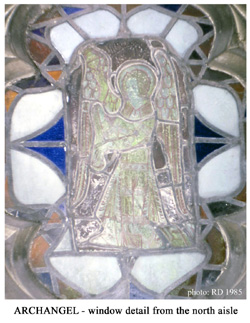 |
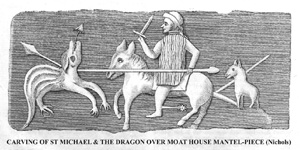 Click images for larger views |
Old Michaelmas
By 1752 the old Julian calendar, which had a leap year every four years, had drifted away from the seasons by 11 days. In that year a correction was made by removing eleven days and refining the leap years: years divisible by 100 were no longer to be leap years unless they were also divisible by 400. Many clergy, unwilling to omit any days, continued to observe feasts according to the 'old style' calendar for many years. Consequently, from that date, St Michael's Day or Michaelmas Old Style or Old Michaelmas Day was celebrated on 10th October rather than 29th September (3).
Hiring Fairs and Wakes Week
In the agricultural world, this was the time of hiring skilled workmen for the coming year. A hiring fair often known locally as the Statute Fair, or simply the Statutes, was held during Wakes Week. The fair's origin was in the Statute of Labourers of 1351 - an (unsuccessful) attempt to freeze wages after the Black Death when, with labour in short supply, workmen began to demand their price for employment. By the 19th century workmen were still going to hiring fairs in search of new jobs and farmers were on the look-out for good workmen. Over the years the holiday accompanying the hiring fair developed into a week of celebration.
Many Fairs are still held in country towns which have their origin in the ancient custom of hiring, although they now exist simply as fun fairs. Local examples are the Statute Fairs of Ashby de la Zouch and Burton upon Trent, as well as the Nottingham Goose Fair. However Michaelmas, like Lady Day six months earlier, remains a defining point in the farming year when rentals are paid and tenancies renewed.
Appleby Wakes Week
In Appleby, Wakes Week followed Old Michaelmas, 10th October (4). The hiring aspect of Appleby Wakes Week appears to have ceased by the early 19th century. Nathaniel Tunnadine was taking on servants privately at dates other than Wakes Week and those leaving him were seeking employment at Ashby and Bagworth Statutes, although not apparently at Appleby. So by the 1830s Appleby Wakes Week had become a week of holiday and recreation (5).
Michaelmas was a natural time of year, after the harvest, for rejoicing and relaxation. Wakes Week has been described as a 'week of extravagance after a year of under-pay and over-work' (6). Some of the customs associated with the Old Michaelmas Wakes Week have been described by A R Wright. In Gloucestershire 'there are family gatherings, a special dish for the occasion and open house, especially at the smaller inns'. At Stone in Staffordshire 'early in the nineteenth century [the wakes] must have been a Saturnalia of a pronounced type. Bull-baiting, bear-bating, dog-fighting, cock-fighting were some of the chief attractions to numerous visitors to the wakes' (7).
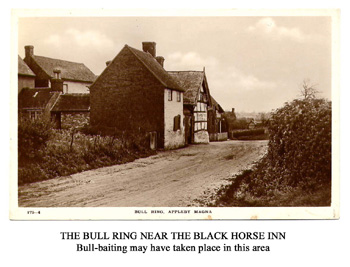 Click for larger view |
Although there is no evidence of the more extreme events taking place in Appleby, the Adelaide Inn, with 'open house', was the focus of many of the celebrations (see below); and part of Top Street, near the Black Horse Inn, is traditionally known as the Bull Ring, where bull-baiting may have taken place.
A Time for Marriages and Baptisms
In the years following the Appleby enclosures (1772) the lives of the villagers were dominated by their employment, with little time off for holiday and recreation. This must lie behind an unusual phenomenon, perhaps unique to Appleby, in which there was a large increase in numbers of October marriages and baptisms and which, as we shall see, was associated with Wakes Week.
There must always have been some seasonal variation in numbers of people getting married at various times of years; and perhaps also a similar, but lesser, variation with baptisms. Averaged over a long period, one would expect about one twelfth of all marriages or baptisms to take place each month. However, Lent was a season when marriage and to a lesser extent baptism was not encouraged. Equally, at harvest time, when everyone was busy, these ceremonies may also be expected to have had a quiet period. This certainly seems to have been the case in Appleby in the 17th century, with numbers dipping during March and August. Allowing a correction for these, in the other months of the year we might consequently expect around 10% of annual marriages or baptisms, i.e. one in ten, to take place in each of the active months.
From yearly totals of marriages and baptisms, I calculated the proportions of these ceremonies which took place in the month of October. They were averaged for 20-year periods from 1721 to 1840 (8). The results, which were quite unexpected, are plotted on the first chart.
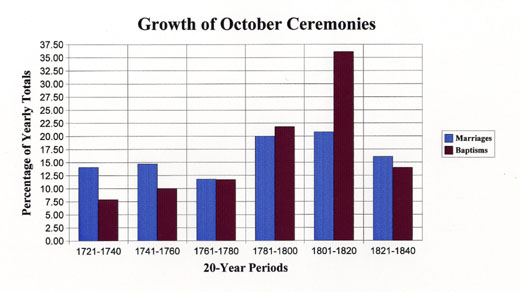
It may be seen that in the late 18th century there was a great increase in October marriages and baptisms, which reached a peak during the first 20-years of the 19th century.
Marriage in October appears to have already been a popular choice in the early 18th century with one in seven couples (14%) choosing to get married then. This level fluctuated a little in the following decades but from 1781 onwards a significant rise occurred. In the years 1781-1800, one in five couples (20%) chose an October wedding and in 1801-1820 the figure was even higher. By 1821-1840 the levels fell away to one in six (16%) but not yet back to early 18th century levels.
October baptisms were near the expected average monthly level of one in ten (10%) in the first part of the 18th century. However, from 1781-1800 numbers took off dramatically reaching a peak of 35% in the years 1801-1820, a quite extraordinary level. One thirdof all baptisms were being performed in October. In the following period baptism levels fell away, as the marriage levels did, to one in seven (14%) in 1821-1840.
To investigate the October peaks further, I then plotted the 1801-1820 figures by day of the month. The second chart shows quite unambiguously that the high numbers of marriages and baptisms took place in Wakes Weekfollowing Old Michaelmas Day, October 10th.
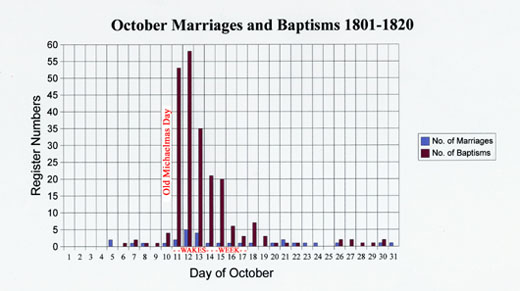
My conclusion from this is that, following the 1772 enclosures and the changing social situation in the village, there was a revival of the custom of Wakes Week as an annual holiday (9). This provided an opportunity for getting married and bringing children for baptism – perhaps especially the children of those who had been married in Wakes Week in previous years. The clergy would have been only too willing to oblige. As the years went on, what began as necessity became an acclaimed custom. Wakes Week had become a great annual occasion on which marriage, family, renewal of employment and seasonal thanksgiving were all enthusiastically celebrated.
Decline
The first chart shows that numbers fell away rapidly by 1821-1840. Times were changing again. With the development of industry in Measham and Ashby Woulds, the squire and the rector were beginning to lose some of their grip over the villagers' lives. Within the village, a non-conformist movement had begun with the establishment of Baptist chapels, soon to be followed by a Methodist chapel. I shall look at these in the next article.
Into the Twentieth Century
Wakes Week in Appleby survived as an annual fair well into the 20th century. The Boys School log-book kept by successive headmasters, Mr William Guy (1873-1886), Mr William Riley (1887-1925) and Mr S C Robinson (1925-27), show that the boys had a holiday – a half day or a whole day - for 'Appleby Wake' or simply 'the Wake', through much of that period. In 1919 there was a whole week: 'Oct 10th, Closed the School today for the usual week's holiday for the Wake and potato picking'. There is a similar entry for Oct 8th 1920 and in 1921 a whole week was again taken. During and immediately following the First World War there was clearly a need for the children's labour to help get in the potato harvest (10).
Personal Memories
Appleby Wakes were celebrated from the Saturday nearest to October 10th and lasted for a whole week. In 1985, Mrs Mabel Nickels recalled that in her younger days the village was visited by a fun fair which was held on the 'Knob', an open piece of ground on the corner of Church Street and Bowleys Lane, where Adelaide House and No. 1 Bowleys Lane now stand. It was alongside the Adelaide Inn, in Church Street, where many of the evening activities took place. There was a dance every night and, to accommodate this, a partition between the Tap Room and the Parlour was moved back and some of the furniture removed. The dancing was accompanied by a small group of musicians who played a concertina, a 'kind of cello' and a piano. This Appleby band supplied the music at many dances in this and neighbouring villages.
Mr Aubrey Moore remembered the Wakes 'since I was about four or five, just before the turn of the century'. According to Mr Moore, the fair was held in the Adelaide field, rather than the Knob, which he thought would have been too small. The Adelaide field was across the road from where Mr Tunnadine's ironmongery shop stood and from where Wren Close is now. Mr Moore was remembering an earlier period and maybe the Knob was used later when the fair had been scaled down. Mrs Nickels said that Mr Tunnadine did not approve of the visit of the fair.
About the Adelaide field Mr Moore wrote 'Whether it belonged to the pub or to Joe Cookson who ran the pub, I do not know, but this field “housed” a number of events such as rabbit coursing with live rabbits and pigeon shooting with live pigeons. Both cruel and unfair “sport” and made illegal early in my life.' The fun-fair consisted of 'swing boats, roundabouts, coconut shies and various other attractions, all a penny each'. With regard to evening entertainment: 'there was jollification at the pubs' all of which did well; and there were 'a few fights, especially on the last Saturday'. He too remembered the band. It operated at most functions with Frank Booton on the concertina and Jimmy Miller on the 'old cello'. 'Those two produced very good dance music of those days – near perfect timing. They could play equally well asleep as awake!' (11).
Whitsuntide and the Friendly Societies
Many Friendly Societies were established as mutual sick clubs in the latter half of the 18th century. Some came under a national organisation such as the Oddfellows and they were usually organised in branches called lodges based at a local public house. Members paid regular weekly contributions, which were collected at the pub. The Appleby Old Friendly Society seems to have operated from the Crown Inn. Members were entitled to financial support from the club when sickness prevented them from working. There were other benefits such as burial fees payable to a member's widow at his death (12).
Records survive for the Appleby Old Friendly Society from 1779, when the first accounts were made, to 1924 when the society was closed. This would appear to have been a society independent of any national organisation. The fact that rules were drawn up in 1856 shows that such bodies were required to adhere to nationally drawn up standards (13). By 1890, a branch of the national society of Oddfellows, the Loyal George Moore Lodge, also existed, probably based at the Moore Arms at Appleby Parva.
Whitsuntide Walks
To encourage the sense of society and mutual support amongst the members, as well as to have an enjoyable day's holiday, an annual event took place in the village on Whit Monday. This involved a processional walk by the Old Friendly Society's members behind the lodge banner, a service in the church and a shared meal at one of the pubs. The banner-bearer wore special ceremonial robes which were kept at the Crown Inn (14). Whit Monday was obviously a special annual holiday to which the villagers looked forward with keen anticipation. The Appleby Parish Magazine recorded the celebrations at Whitsun 1890:
Whit-Monday was observed as a general holiday in our village, the weather proving very fine, which added to the hilarity of those bent on making the most of Bank Holiday. The Original Friendly Society this year united with the Loyal George Moore Lodge of Oddfellows in holding their Club Feasts on Whit-Monday. The two Clubs walked in procession to attend Divine Service at the Parish Church, where an eloquent Sermon was preached by Rev. W. S. Bamber, the preacher selecting his text from Galatians vi. 2*. [ * “Bear ye one another’s burdens and so fulfil the law of Christ” - Mr Bamber was Headmaster of Appleby Grammar School.]
After the service the procession was again formed, and the Clubs, headed by the Band, walked to the Moore Arms Inn, where a substantial dinner was provided by Mr. J. W. Bowley. A special feature in the procession this year was the admission of a number of the very Juvenile Members of the Oddfellows, and we commend this step as being one in quite the right direction. After dinner the usual loyal toasts were given from the Chair; then the principal toast, “Prosperity to the two Clubs,” was duly submitted and responded to, and a pleasant day was spent (15).
Dinners and Suppers
The Moore Arms was the location of celebratory suppers and dinners enjoyed by members of various societies or organisations in the village. Before the First World War, the School Governors used to have lunch there after their annual meeting (16). The Church Choir held their annual supper there in the 1890s as did the village Cricket Club (17). The squire also entertained his tenant farmers to lunch at the Moore Arms on the occasion of Rent Day (18). Presumably the lunch 'sugared the pill'.
Rogation Processions
Another annual procession which involved the church was the blessing of the crops at Rogation-tide. It is not clear whether this was a continuous tradition or whether there was a revival when it took place after the Second World War. The accompanying photographs show scenes from the procession now known to have taken place in 1946*. On this occasion the visiting Bishop of Leicester gave the blessings. The procession started from the church and made its way to the top of Rectory Lane and called at the (old) Rectory to bless the rectory fields. The allotments would have been another stop for the newly sown crops to be blessed.
* Grateful thanks to Ann Silins for this information. She was there and has sent another photograph taken in Church Street before the procession set off: see her short article Rogation Day 1946 in the Memories section.
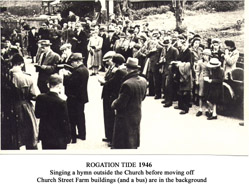 |
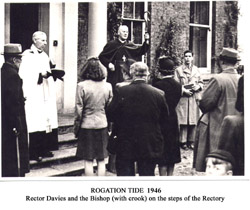 |
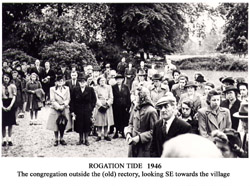 Click images for larger views |
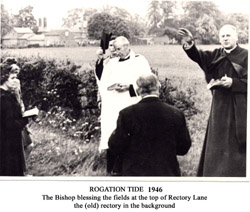 |
Hunts and Hounds
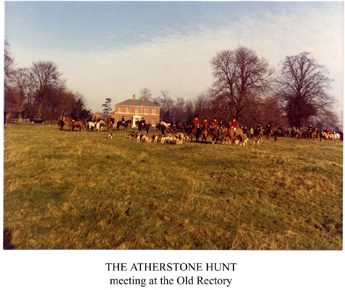 Click for larger view |
Hunting was one of the traditional winter activities in the Midland Shires and was particularly strong in Leicestershire. Appleby was hunting country and the Atherstone Hunt met at one time at Red Lion Farm next to the old cross-roads. Revd. C T Moore, rector 1877-1922, was a particularly keen huntsman. Aubrey Moore recalled that 'to father it was almost a religion and the MFH (Master of Fox Hounds) next to God'. On occasions, Wednesday Lent services were delayed when the Wednesday hunt was late finishing and the rector would arrive in his hunting clothes (19) (20).
Rabbiting
Rabbits were prolific in the countryside. Although they damaged crops, they provided a useful supplement to the diet of many country families (this was especially true during wartime). Catching or shooting rabbits was regarded as an enjoyable pastime for the ordinary countryman or boy.
Before the days of the combined harvester, the first mechanical means of harvesting was by using an adapted horse-drawn hay mower with a rack to collect sufficient straws to form a sheaf, which was then off-loaded and bound by hand with a band of straw. A team of men stationed around the field had this job (21). Later came the reaper-binder or binder pulled by horses or a tractor. The binder ate up the ripened grain as it circuited the field, turning out sheaves bound with twine.
The sheaves were put into shocks or stooks, groups of eight sheaves standing in a double line and leaning against each other. They were placed like this to dry. Finally came the operation known as carrying – moving them to a stack for eventual threshing.
Harvest time was a particular occasion for rabbiting. Cornfields contained many rabbits - and the odd hare. As the uncut area of corn grew smaller, it became alive with rabbits which were shot, or caught by dogs, as they tried to escape. By surrounding the area with men and boys, the escape of rabbits could be controlled making it easier for the guns. To avoid accidents in the excitement, the positions of the men and boys had to be supervised, the dogs had to be under control and the men with shotguns (usually two or three) had to be particularly careful. And it was exciting! There was much unsophisticated enjoyment to be had from such traditional country activities (22).
The 1912 photograph of the Rabbit Shoot up Measham Road below shows men and boys in an Appleby harvest field. Two men with guns may be seen. The 'bag' was said to be 80 rabbits. Behind the group can be seen two horses, one with a boy on its back, and in the foreground lie hand-bound sheaves awaiting stooking.
Notes and References
1. A dedication to St Helen has been recorded for Appleby Church before the Reformation: “Diocese of Lincoln, Archdeaconry of Leicester, Appleby Magna Parish, dedication in 1530 Helen; in 1790 Michael & All Angels” from G R Jones, Database of Saints' Cults, University of Leicester, on-line at www.le.ac.uk/elh/grj1/database/dedleics.html
The name has survived in the parish in St Helen's Bridge which crosses the brook near the Moat House on the Hall Yard footpath; and in St Helens - the small field, near the bridge, on which the lower part of Garton Close was built. I have suggested previously (In Focus 6) that St Helen may have been the medieval dedication of the de Appleby Chapel in the church. This chapel, effectively a family chantry, would have lost its function at the Reformation. In any case, the de Applebys' long tenure of the manor, which stretched back to the 12th century, came to an end in 1549.
2. See In Focus 6 & 7 for more about Appleby Magna Church and Manor
3. In 1752, Wednesday 2nd September was followed by Thursday 14th September, the 3rd to the 13th being omitted. Despite the clear requirements of the 1751 Calendar Act, it was many years before clergy and lawyers adopted the 'new style'. Indeed the financial year end of April 5th remains as a relic of the old style Lady Day (March 25th), which, up to 1752, began the new year.
4. Nichols, op. cit., p 432: 'The wake is kept on St Michael's day, old style'.
5. In Focus 23, Note 9: comment on Nathaniel Tunnadine's diary
6. This memorable phrase was used in a BBC Radio 4 broadcast about Wakes Week c.1985
7. A R Wright, British Calendar Customs England, vol III, Fixed Festivals, Folk Lore Society, 1940
8. R Dunmore, The Parish Registers of Appleby Magna, Leicestershire, Research Essay for Local History Certificate, University of Keele, 1973
9. The moderately high early 17th marriage levels suggest that Wakes Week may always have been a popular time to get married. Before 1752, Wakes Week would have been 11 days earlier, following September 29th, but the week would still have fallen mostly in October.
10. Appleby Free Boys School Log Book, 1871-1927, Leics. RO, E/LB/6/1
11. Aubrey Moore , private letter to the author, 6 January 1978; also Mr Moore's book, A Son of the Rectory, Sutton, 1982, p 90
12. Alan Rogers, This was their World, approaches to Local History, BBC, 1972, pp 192-94
13. Appleby Old Friendly Society, accounts 1779-91, 1831-78, 1877-89, rules 1856, contributors 1874-1920, disbursements 1864-1883, 1883-1920, closure documents 1924 - all taken to Leics. Record Office - PCC minutes 12 Oct 1973
14. The Friendly Society Banner was kept in Appleby church until 1959 when it was taken down for church redecoration. Too fragile to put back, it was offered to Leicester museum - PCC minutes 13 Jan 1959. The late Mr K Emerson arranged for the ceremonial robes, which were kept at the Crown, to be displayed at the Old Appleby Exhibition in 1974.
15. The Loyal George Moore Lodge of the Oddfellows is named in Appleby Parish Magazine for June 1890, in which the account of the walk of that year was given. It seems likely that this lodge operated from the Moore Arms (now the Appleby Inn) at Appleby Parva. The Oddfellows trace their history from medieval trade guilds, catering for those belonging to less well known trades – hence the 'odd'. The word 'fellow' evokes the idea of brotherly support.
16. Aubrey Moore, A Son of the Rectory, op. cit., p 22
17. Appleby Parish Magazines, 1890 . For details and other other social activities in late Victorian times see In Focus 15.
18. Bernard C Ward, private letter to the author, 14 Feb 1978. Mr Ward had information about the Bowley family who ran the Moore Arms for many years.
19. Aubrey Moore, A Son of the Rectory, op. cit., p 34-35, 56
20. Guy Paget & Lionel Irvine, Leicestershire, Robert Hale, 1950. A hunting man, Paget gives an account of the long history of hunting in the 'Shires', including the Atherstone pp 246-7.
21. Aubrey Moore, A Son of the Rectory, op. cit., p 68
22. Some of this section is based on my own boyhood experience in the Northamptonshire countryside of the 1940s.
©Richard Dunmore, March 2004
Previous article < Appleby's History In Focus > Next article


